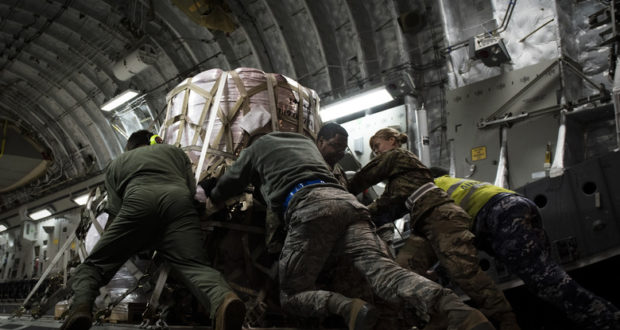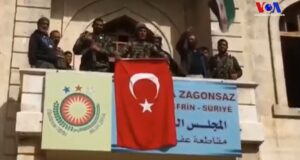9 February, 2020
By Oliver Hegglin – Research Assistant
Part I: The Bushfires
For months, images of red skies and towering columns of smoke have spread across the global media. While bushfires in Australia occur every year, the magnitude of the current blazes since September has reached an unprecedented level of catastrophe. In November, a state of emergency was declared in New South Wales and on the first day of the New Year, Canberra experienced the worst air pollution in recorded history.
Though storms have hit the fires, many continue to burn. By mid-January, some 28 people had been confirmed to have died, about 2,000 homes had been destroyed or damaged, over one billion mammals, birds and reptiles had been killed and on Kangaroo Island alone some 25,000 Koalas are feared dead. To date, approximately 17 million hectares of land have been scorched.
Operation Bushfire Assist
Some 6,500* Australian Defence Force (ADF) Personnel are actively involved in Operation Bushfire Assist. Assets from the Army, Navy and Air Force have been deployed in a variety of functions to support firefighters and assist civilians. Since the beginning of the operation, the ADF has been keeping a record of all its activities.
Part II: The International military response
Operation Bushfire Assist is also receiving support from five foreign armed forces. As of 23 January, the ADF counts a total of 380 foreign military personnel as follows*:
- 87 New Zealand Defence Force
- 99 Papua New Guinea Defence Force
- 50 Singapore Air Force
- 80 Japan Self-Defence Force
- 54 Republic of Fiji Military Forces
- 10 United States Air Force
The ANZAC Spirit
Australia’s closest and most important partner, New Zealand, has provided helicopters, fixed-wing aircraft and plans to have over 100 troops in Australia. One aircraft technician testified that, “you feel pretty helpless being here in New Zealand, but being over there in the thick of it will be quite rewarding. The ANZAC spirit really comes out.” The point of departure for New Zealand Defence Force (NZDF) assets was Royal New Zealand Air Force (RNZAF) Base Ohakea.
Three NH90 transport helicopters have been ferried over to RAAF Base Richmond in RAAF C-17A Globemaster IIIs, based in RAAF Base Amberley, due to New Zealand not having the capacity to haul the helicopters by themselves. Two of these helicopters have helped transport Australian Army personnel and equipment to Defence Establishment Fairbairn to support Stockyard firebreaking clearing.
A Royal New Zealand Air Force (RNZAF) C-130 Hercules transported 50 combat engineers and later firefighting foam out to RAAF Base Edinburgh, destined for Kangaroo Island. These engineers are supporting debris and route clearance to enable Freedom of Movement for emergency crews, and set up a water treatment facility at Vivonne Bay while supporting repair tasks in the area.
Reciprocal Action from Japan
Contributing from nearly 8,000 km away, the Japanese Air Self-Defence Force (JASDF) deployed two C-130 Hercules carrying 70 JASDF personnel, initially landing at RAAF Base Richmond on 16 January, joining eight Japanese troops already there. Colonel Masashi Ota, head of the Japanese mission, said (in reference to the 2011 Earthquake and Tsunami in Japan), “The Australian Air Force deployed many military aircraft to support Japan’s recovery and that was a great help for us, we will never forget what Australia did (for Japan) at that time.”
Commenting on the Japanese contribution, RAAF Air Commodore Carl Newman is quoted as saying, “The additional C-130s that the Japanese are bringing out will be vital in helping us out. It is a true reflection of friends helping each other in crisis.” The first mission the Japanese assets were deployed on was to Kangaroo Island as well, delivering cargo and personnel to fire-affected areas of the island, such as Kingscote, and returning to the mainland to RAAF Base Edinburgh.
Training partner Singapore
Thanks to a training agreement, Singapore maintains two CH47 Chinook helicopters in Australia, which were deployed to RAAF Base East Sale along with 42 Singapore Armed Forces (SAF) personnel. These are being used to deliver firefighting and relief supplies into affected zones while evacuating residents and providing humanitarian assistance to remote and isolated communities within distance to RAAF Base East Sale, flying as far out as Melbourne.
Singapore Defence Minister Ng Eng Hen said, “Australia has welcomed SAF troops to train there for decades, and in their time of great need, it’s only natural that the SAF do our best to help their people and communities affected by this unexpected natural disaster.”
Closest friend of Papua New Guinea
Papua New Guinea was quick to have 1,000 soldiers and firefighers standing by to support Australia at their request. Prime Minister James Marape commented, “Australia is the closest friend of PNG and is always the first in PNG in our times of adversities and we offer our hearts and our hands to you in this time of fire-induced tragedies.”
A few days after this offer was made, Australia accepted help and an initial deployment of 100 field engineers prepared to be picked up by an RAAF C-130J Super Hercules transport aircraft. The first task of their three-month deployment was to work alongside their Australian counterparts in the Victoria region in clearing roads from debris and fallen trees.
Solidarity from Fiji
Support also came from the island nation Fiji. Prime Minister Frank Bainimarama wrote to the Australian Prime Minister Scott Morrison, offering “assistance in any way we can to deal with this crisis.” However it was an RNZAF aircraft, a Boeing 757-2K2(C), which was sent to Fiji to pick up the troop contribution and then bring them to Australia, where the 50 Republic of Fiji Military Force (RFMF) engineers began work alongside ADF counterparts, just as the Papua New Guineans, in clearing operations, the difference being their area of operation is the Orbost region, after an induction in Puckapunyal.
United States Oversea Territory
In mid-January, the United States offered critical fire retardant powder from its Air Force Base Nellis, in Nevada, which was picked up and delivered by the RAAF. Later in the month, the United States Air Force (USAF) deployed two five-person cargo load teams from the 36th Contingency Response Group, based in Andersen Air Force base on the United States Territory of Guam in the Pacific Ocean. These teams were deployed to RAAF Base Richmond and RAAF Base East Sale.
Part III: An unprecedented crisis
RAAF Air Commodore Carl Newman admitted, “It is very rare to receive support from international partners. This is an unprecedented crisis for Australia and the size and scope and the geography that it is occurring … needs a large requirement for logistic support.”
Even technologically advanced countries with vast resources can be in need of support from abroad. Much of the support Australia is receiving is in part due to reciprocity; Australia aided Japan during the 2011 earthquake and tsunami, Papua New Guinea benefited from Australian assistance in the past and Fiji received support after Tropical Cyclone Winston in 2016, the worst in Fiji’s history.
As a technologically modern, regional, yet smaller however not insignificant power, New Zealand’s assistance has been not only comparatively high in manpower but also vital through its aerial assets. Listed as priorities under New Zealand’s security interests, “to discharge our obligations as an ally of Australia” and “to make credible contribution in support of peace and security in the Asia-Pacific region” are two of the multiple goals presented in the White Papers of the NZDF. Its contribution is indicative of the ANZAC spirit that has connected New Zealand and Australia for over 100 years. As an ally to both Australia and New Zealand, the American contribution can be attributed to partners supporting each other in a time of need.
Part IV: Far from over
Climate change is causing weather extremes unseen in modern times. As temperatures spike in both the positive and negative, natural disasters such as bushfires and hurricanes will continue to increase in severity around the globe. As a result, armed forces around the world will continue to be tasked with responding to these natural disasters in an effort to limit damage to the environment and save lives.
States are undoubtedly aware that future storms and natural disasters will wreak havoc on their territory, including those involved in Operation Bushfire Assist. With small states with limited resources contributing to Australia’s crisis mitigation efforts, a message is being sent that a partnership in these types of military operations will be crucial in the future as they hope Australia will continue to be there to support them in their time of need, just as Australia has been in the past.
This is not to say that good-will does not play a part, as the South-Pacific is a very peaceful and stable part of the world with strong bonds between neighbors. Military humanitarian assistance serves to strengthen this friendly bond, building trust and creating respect.
Climate change has been declared to be the “single greatest threat to the livelihoods, security and wellbeing of the peoples in the Pacific” in the Boe Declaration on Regional Security. As a result, it is only natural and advisable for armed forces in the Pacific and elsewhere to place heavy emphasis on developing their humanitarian relief and disaster response capacities, whether it be acquiring the proper ground, naval and aerial equipment or simply ensuring training for future contingencies similar to Operation Bushfire Assist.
Australia will remember these military contributions from abroad. The comparatively large nation is a natural regional leader in military capabilities, as the ADF has vessels, equipment and experience that will be called upon during the next crisis. Through Operation Bushfire Assist, Australia and its partners continue to develop interoperability, a crucial feat which will be called upon to face future challenges in the South Pacific region.
Image: Members of the 99th Logistics Readiness Squadron and the Royal Australian Air Force push a pallet of fire suppressant up the ramp of an Australian C-17 Globemaster III (Source: U.S. Air Force photo by Senior Airman Jeremy Wentworth)
* Please note, as Operation Bushfire Assist is ongoing at the time of writing and publication of this article, Australian and foreign troop and aircraft numbers may have changed. Please refer to https://news.defence.gov.au/national/operation-bushfire-assist-2019-2020 for the most recent information.
 Human Security Centre Human Rights and International Security Research
Human Security Centre Human Rights and International Security Research




